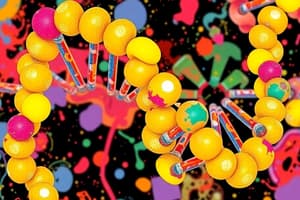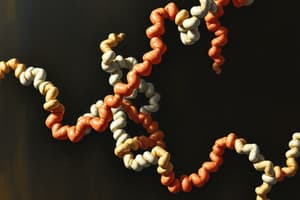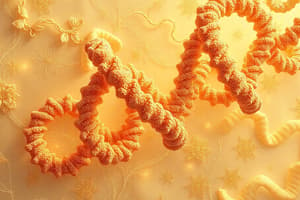Podcast
Questions and Answers
What is the primary structure of a protein?
What is the primary structure of a protein?
- The 3D shape of a single polypeptide chain
- The local folded structures formed by hydrogen bonds
- The arrangement of multiple polypeptide chains in a protein complex
- The linear sequence of amino acids in a polypeptide chain (correct)
Which type of bond is primarily responsible for stabilizing the secondary structure of proteins?
Which type of bond is primarily responsible for stabilizing the secondary structure of proteins?
- Disulfide bridges
- Peptide bonds
- Ionic bonds
- Hydrogen bonds (correct)
What characterizes the tertiary structure of proteins?
What characterizes the tertiary structure of proteins?
- The arrangement of polypeptide chains in a complex
- The coiling of polypeptide chains into alpha helices
- The overall 3D shape of a single polypeptide chain (correct)
- A linear sequence of amino acids
How do beta-pleated sheets differ from alpha helices?
How do beta-pleated sheets differ from alpha helices?
What is an example of a protein with quaternary structure?
What is an example of a protein with quaternary structure?
What stabilizes the alpha helix structure in proteins?
What stabilizes the alpha helix structure in proteins?
Which feature is characteristic of quaternary protein structures?
Which feature is characteristic of quaternary protein structures?
What is the role of hydrogen bonds in secondary protein structures?
What is the role of hydrogen bonds in secondary protein structures?
Flashcards
Primary Protein Structure
Primary Protein Structure
Linear sequence of amino acids in a polypeptide chain, linked by peptide bonds.
Secondary Protein Structure
Secondary Protein Structure
Local folded structures in a polypeptide, stabilized by hydrogen bonds.
Alpha Helix
Alpha Helix
Spiral structure stabilized by hydrogen bonds between amino acids 4 residues apart
Beta-Pleated Sheet
Beta-Pleated Sheet
Signup and view all the flashcards
Tertiary Protein Structure
Tertiary Protein Structure
Signup and view all the flashcards
Quaternary Protein Structure
Quaternary Protein Structure
Signup and view all the flashcards
Study Notes
Protein Structure
- Primary Structure: The linear sequence of amino acids linked by peptide bonds.
- Secondary Structure: Local folded structures formed by hydrogen bonds between backbone atoms. Common types include alpha helices (stabilized by hydrogen bonds between a carbonyl oxygen and an amide hydrogen), and beta-pleated sheets (stabilized by hydrogen bonds between adjacent strands).
- Tertiary Structure: The overall 3D shape of a single polypeptide chain, stabilized by interactions including hydrogen bonds, ionic bonds, hydrophobic interactions, and disulfide bridges. This structure dictates the protein's function.
- Quaternary Structure: Exists when multiple polypeptide chains (subunits) combine to form a functional protein complex (e.g., hemoglobin). This structure also relies on the same interactions seen in tertiary structure.
Alpha Helix and Beta-Pleated Sheet
- Alpha Helix: A common secondary structure where the polypeptide chain coils into a right-handed spiral stabilized by hydrogen bonds between the carbonyl oxygen and amide hydrogen of amino acids four residues apart.
- Beta-Pleated Sheet: Another common secondary structure where polypeptide chains lie alongside each other. Hydrogen bonds form between adjacent strands, creating a sheet-like structure. Antiparallel sheets are more stable than parallel sheets. Arrows indicate the direction of the protein chain.
Studying That Suits You
Use AI to generate personalized quizzes and flashcards to suit your learning preferences.




